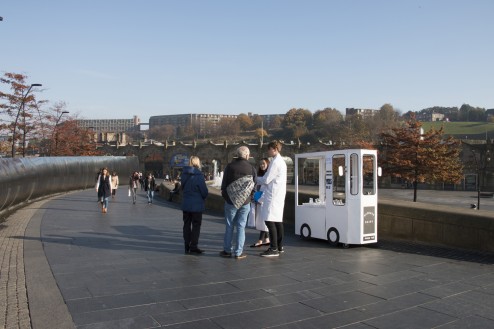
Year | 2015
Location | Park Hill, Sheffield, UK
Client | Leila Alexander, Executive Director, S1 Artspace









Originally built to replace a series of slums, the Park Hill estate was designed to establish a strong sense of community within the development. In the following years various social issues transformed this celebrated community into a hot spot of crime. The Duke Street building is one portion of this estate and has been highlighted by new developers Urban Splash as a potential site for the development of a new cultural centre. This proposal is being developed by local arts organisation S1 Artspace and would provide space for creative working studios as well as an art gallery. This Live Project investigated how a heritage offer could be integrated within this proposal to celebrate all aspects of the estate’s past.
The live project is seen as a catalyst to secure heritage lottery funding and to maximise the potential effect and usability of the development for the community, for S1 and for other stakeholders. The project culminated in an event ‘Parkive’, an opportunity for the various stakeholders to interact in discussion with as well as the live project team, gaining feedback for the future.
Prior to the ‘Parkive’ event, research and engagement considered three distinct strands.
– The first saw us undertake a range of interviews with academics outlined by the client and developed throughout the project, that have direct involvement or interest with the development. Interviewees included Harry Bowell from the National Trust, Tom Bloxham MBE from Urban Splash and Jeremy Till- Head of Central Saint Martins.
– The second saw us engage with the more indirect user of an archive – the general public. For this the narrative of a milk float, once prominent on the ‘streets in the sky’, created an interactive experience gathering thoughts, opinions and interests about Park Hill and a potential archive covering the past, the present and the future. The Milk float has become a physical part of the live project legacy.
– Thirdly, communication with artists and patrons of S1 Artspace began a process of determining how they would use the archive and allow it to influence their work.
A key conclusion surrounding this research was that the archive for Park Hill should be considered living, not just collecting the past stories and architectural heritage from history, but continuously documenting and recording the forthcoming changes. The Heritage strand as a whole is therefore seen as progressive, animating the past but also the future.
The research was compiled into a manifesto, considering the heritage offer as part of a wider cultural network and as a continuum that presents Park Hill as a living, breathing and on-going process. The manifesto also suggests spatial connections that link the archive to the larger organisation of spaces that make up the S1 Artspace vision, expanding the potential usability and access of an archive, and developing core S1 values that include collaboration and sharing. We hope that by celebrating the Park Hill of the past this will inform and enrich the Park Hill of the future.

